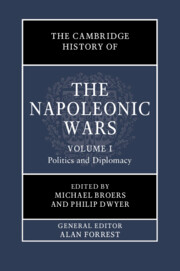Book contents
- The Cambridge History of the Napoleonic Wars
- The Cambridge History of the Napoleonic Wars
- The Cambridge History of the Napoleonic Wars
- Copyright page
- Contents
- Figures and Tables
- Maps
- Contributors to Volume I
- Acknowledgements
- General Introduction
- Introduction to Volume I
- Part I The Origins of the Napoleonic Wars
- Part II Napoleon and his Empire
- Part III War Aims
- 14 French Preponderance and the European System
- 15 Habsburg Grand Strategy in the Napoleonic Wars
- 16 Prussian Foreign Policy and War Aims, 1790–1815
- 17 British War Aims, 1793–1815
- 18 Alexander I’s Objectives in the Franco-Russian Wars, 1801–1815
- 19 Ottoman War Aims
- 20 Spain and Portugal
- 21 War Aims: Scandinavia
- Bibliographical Essays
- Index
17 - British War Aims, 1793–1815
from Part III - War Aims
Published online by Cambridge University Press: 13 October 2022
- The Cambridge History of the Napoleonic Wars
- The Cambridge History of the Napoleonic Wars
- The Cambridge History of the Napoleonic Wars
- Copyright page
- Contents
- Figures and Tables
- Maps
- Contributors to Volume I
- Acknowledgements
- General Introduction
- Introduction to Volume I
- Part I The Origins of the Napoleonic Wars
- Part II Napoleon and his Empire
- Part III War Aims
- 14 French Preponderance and the European System
- 15 Habsburg Grand Strategy in the Napoleonic Wars
- 16 Prussian Foreign Policy and War Aims, 1790–1815
- 17 British War Aims, 1793–1815
- 18 Alexander I’s Objectives in the Franco-Russian Wars, 1801–1815
- 19 Ottoman War Aims
- 20 Spain and Portugal
- 21 War Aims: Scandinavia
- Bibliographical Essays
- Index
Summary
‘It is not our business to collect trophies, but to try … [to] bring back the world to peaceful habits’, remarked Lord Castlereagh, the British Foreign Secretary, after Napoleon’s final defeat at Waterloo.1 Castlereagh’s image of his country as an impartial arbiter was not shared by other European powers, with whom Britain had formed seven coalitions during the twenty-two years of the wars with Revolutionary and Napoleonic France. Great Britain was more often impugned by them as ‘Perfidious Albion’, with a grasping imperial and commercial policy and a divide-and-rule approach to its nearest neighbours. Nonetheless, Castlereagh’s claim did convey certain realities about the position adopted by the British state throughout the two final coalitions against Napoleonic France. With the significant exception of Hanover (of direct concern to King George III in his capacity as hereditary elector) and strategic outposts in the Mediterranean, Britain did not have any major European territorial demands in the war, or the peace that followed.
- Type
- Chapter
- Information
- The Cambridge History of the Napoleonic Wars , pp. 352 - 371Publisher: Cambridge University PressPrint publication year: 2022



